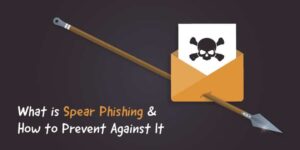What is Spear Phishing and Anti Phishing Techniques To Prevent It
Published on: 14 Jan 2019
Last modified on: 28 Nov 2025

Spear Phishing: Understanding and Preventing Targeted Cyberattacks
Phishing comes in many forms, but spear phishing is one of the most dangerous and hardest to detect. Unlike traditional phishing, which casts a wide net, spear phishing is highly targeted and personalised, often tailored to specific individuals or organisations.
Attackers spend significant time researching their targets, collecting personal information from social media, search engines, and other online sources to make their fraudulent emails appear authentic. They may impersonate trusted colleagues or friends, tricking recipients into disclosing sensitive information.
For example, an employee might receive a seemingly legitimate email from HR about a new pension scheme. Clicking an attachment in such an email could unknowingly release malware capable of disrupting an entire organisation. While this may sound dramatic, targeted spear phishing attacks occur daily across the globe.
Spear phishing can generate enormous profits for cybercriminals. In 2015, Ubiquiti Networks lost over $40 million due to a spear phishing attack. Similarly, the Carbanak Cybercrime Group has stolen more than $1 billion from banks worldwide using malware delivered through spear phishing emails.
Effective Anti-Phishing Techniques to Prevent Spear Phishing
1. Don’t Overshare on Social Media
Social media makes it easy for attackers to gather personal details, such as your job role, workplace, email, and events you attend. Limit the information visible on your profiles and regularly adjust privacy settings to minimise risk.
2. Question Requests for Confidential Information
Never automatically comply with requests for sensitive information, even if the email appears to come from a senior executive. Verify requests personally before sharing passwords, corporate banking details, or confidential files.
3. Avoid Clicking Suspicious Links
Spear phishing emails often include a convincing link to trick users. Always hover over links to check their true destination. If anything seems unusual, do not click. Learn more about handling phishing links here.
4. Use Strong Passwords and Passphrases
Create complex passwords or passphrases combining letters, numbers, symbols, and spaces. This increases security and makes it harder for attackers to compromise your accounts.
5. Regular Cybersecurity Awareness Training
Staff should receive ongoing training to identify spear phishing attempts. Awareness of the latest techniques reduces the likelihood of employees falling victim to targeted attacks.
6. Keep Software Up to Date
Regular updates to anti-virus and security software protect against newly discovered vulnerabilities. Staying current reduces the chance of hackers exploiting outdated systems. More on anti-virus protection here.
7. Implement Multi-Factor Authentication (MFA)
MFA adds an extra layer of security by requiring additional verification beyond passwords. This significantly reduces the risk of account compromise. Learn why MFA isn’t optional.
For more guidance, explore our Ultimate Guide to Phishing.
Explore Our Human Risk Management Solutions
Protecting your organisation from spear phishing and other cyber threats requires a comprehensive approach that combines awareness, simulation, analytics, and compliance management. Our solutions are designed to help organisations reduce human risk, strengthen cybersecurity culture, and ensure compliance across all levels.
- Human Risk Management Platform – Centralise and monitor human risk across your organisation.
- Automated Security Awareness – Deliver engaging, personalised security awareness training to all staff.
- Advanced Phishing Simulations – Test and improve staff resilience against real-world phishing attacks.
- Risk Intelligence & Analytics – Gain actionable insights into your organisation’s human risk profile.
- Compliance Management – Ensure your organisation stays compliant with regulatory and internal requirements.
Want to see how our solutions can protect your organisation? Contact us today for more information or to request a free demo. Our experts are ready to help you reduce human risk and strengthen cybersecurity awareness.
FAQs on Spear Phishing and Cybersecurity
What is spear phishing?
Spear phishing is a targeted phishing attack aimed at specific individuals or organisations to steal sensitive information.
How is spear phishing different from regular phishing?
Unlike generic phishing, spear phishing is personalised, often using detailed personal information to make emails seem legitimate.
Are spear phishing attacks common?
Yes, targeted spear phishing attacks are a frequent and growing threat worldwide.
What is social engineering?
Social engineering is the psychological manipulation of people into performing actions or revealing confidential information. Spear phishing is a form of social engineering that exploits trust and human behaviour rather than technical vulnerabilities.